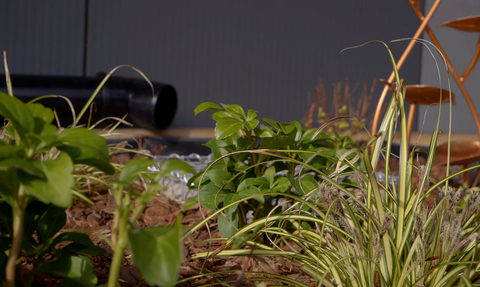
Rain gardens
What is a rain garden?
A rain garden can come in several different formats; either a shallow depression or a raised planter. They are designed to capture rain water flowing off roofs and slow the flow of the water back into drains and eventually watercourses.
Rain gardens can help to reduce flooding by storing rain water and reduce pollution by filtering water, whilst also allowing you to create a wildlife friendly feature for your garden that may need less maintenance and watering.

Why make a rain garden?
Extensive areas of sealed surfaces like tarmac in towns and cities cause problems in heavy rainfall, with drains often becoming overwhelmed. When this happens localised flooding can occur, damaging property and blocking streets. In some cities water run-off into drains may wash oil, heavy metals and other pollutants into watercourses, damaging the plants and animals that live in aquatic environments.
These problems have become worse as towns and cities have grown and are expected to be exacerbated by climate change, which is likely to bring about more frequent and heavier downpours. One of the most effective ways of tackling these problems and adapting to climate change is to increase the quantity and quality of vegetation and soils in towns and cities.

Rain Garden diagram by Holly Turner
The three key functions of rain gardens
Habitat for wildlife
Rain gardens can be planted with native, nectar-rich plants, providing food for pollinators such as butterflies, bumblebees and hoverflies.
Reduce flooding
They act like a sponge, soaking up and storing large amounts of water when it rains, reducing the burden on main drainage systems.
Clean water
Debris, chemicals, dirt and other pollutants are removed from rain water by filtering it through layers of sand, soil, compost and gravel.
Rain gardens in Cinderford
We've been working in partnership with Severn Trent and the Environment Agency to install five rain gardens at community buildings across the town and create two depave gardens in the market triangle.
Three metal planters were designed for the Forest Community church building, which is used throughout the week as a food bank, play group space and warm space. The planters were filled with plants that are not only good for pollinators but are tactile too, creating a calming sensory space for children to interact with nature.
Two rain gardens were installed at the Miners Welfare hall, constructed from locally-sourced timber. The planters were built, lined and planted up by staff and volunteers, and drainpipes from the roof have been diverted to allow rainwater to flow from the roof into the gardens.
Two large depave areas in the town centre will not just tackle the problems of flash-flooding and run off, but provide a highly visible talking point too. Once the plants have filled out it will provide an attractive and pollinator-friendly place, right in the middle of town.
Rain gardens in Gloucester
We're working in partnership with The Environment Agency and Gloucester City Council to create healthy, functional watercourses for people and wildlife. As part of this work seven rain gardens have been created in Gloucester.
Examples of a planter-style rain gardens can be seen at Abbeydale Community Centre, The Friendship Café and a sunken rain garden has been created outside the Matson Baptist Church in Gloucester.
We've also been working closely with Gloucester Rugby Club and the Environment Agency to install rain gardens at Kingsholm Stadium. Here's Engagement Project Officer Holly Turner, to explain how, with a helping hand from Gloucester Rugby winger Ollie Thorley.
How to make a rain garden?
Choose the right location
Rain gardens are best located at low points where surface water will flow. However, the location might be determined by the downpipes from your guttering, ideally below a downpipe and near an existing drain.
How big should my rain garden be?
The bigger the better, however if space is an issue then any size rain garden will help. Ensure you construct an overflow to take excess water back to the drain to avoid flooding.
Construction
Hand digging is best when constructing a sunken garden to ensure you don’t hit any buried existing services. If constructing a planter-style rain garden, ensure there is a solid bottom to retain water. Layers of substrate should be approximately 26% gravel at the bottom, next a 13% sand layer, then a 53% sand/soil mix and finally 7% gravel mulch on top. Work out exact quantities based on the size of your planter and consult a detailed guide. Ensure your overflow pipe is at least 100mm above the top of the gravel mulch and 100mm below the top.
Planting
Consider how much sunlight your garden will get and how much water will flow from the roof. You could plant shrubs such as dogwood and guelder rose, or smaller flowering plants such as bugle, yellow flag iris, ferns, sedges and grasses.
Maintenance
Your garden may need weeding occasionally and some plants might need replacing. Keep checking your overflow pipes to make sure they are draining freely and not blocked up.
For a more detailed guide to build your own rain garden please visit:
• Rain gardens
• Environment Agency
You can download a copy of the UK rain garden guide here.
To find out more about river improvement works in Gloucester please visit the Environment Agency's website.







